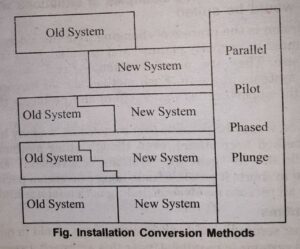
Explain the four forms of Information system conversion strategy namely plunge, parallel, phased and pilot? Give examples of situations where each would be suited.
Explain the four forms of Information system conversion strategy namely plunge, parallel, phased and pilot? Give examples of situations where each would be suited.
Ans.
Conversion is the process of changing from the old system to the new one. It must be properly planned and executed. Four methods are common in use. They are: parallel systems, direct conversion, pilot system and systems phase-in. Each method should be considered in the light of the opportunities that it offers and problems that it may create.
However, it may be possible that sometimes, we may be forced to apply one method over others, even though other methods may be more beneficial. In general, systems conversion should be accomplished in shortest possible time. Long conversion periods create problems for all persons involved including both analysts and users.
Parallel Systems
The most secure method of converting from an old to new system is to run both systems in parallel. Under this approach, users continue to operate the old system in the usual manner but they also start using the new system. This method is the safest one because it ensures that in case of any problems in using the new system, the organization can still fall back to the old system without loss of time and money.
The disadvantages of the parallel systems approach are:
- It doubles operating costs.
- The new system may not get fair trial.
Direct Conversion/Plunge
This method converts from the old to the new system abruptly, sometimes over a weekend (even overnight). The old system is used until a planned conversion day, when it is replaced by the new system. There are no parallel activities. The organization relies fully on the new system. The main disadvantages of this approach are: no other system to fall back on, if difficulties arise with new system. Secondly, wise and careful planning is required.
Pilot System
Pilot approach is often preferred in the case of the new system which involves new techniques or some drastic changes in organization performance. In this method, a working version of the system is implemented in one part of the organization, such as a single work area or department. The users in this area are aware that they are piloting a new system and that changes can be made to improve the system. Based on the feedback, changes are made and the system is installed in the remaining departments of the organization, either all at on (direct conversion method) or gradually (phase-in method). This approach provides experience and live test before implementation.

Phase-in Method
This method is used when it is not possible to install a new system throughout an organization all at once. The conversion of files, training of personnel or arrival of equipment may force the staging of the implementation over a period of time, ranging from weeks to months. It allows some users to take advantage of the new system early. Also it allows training and installation without unnecessary use of resources.






